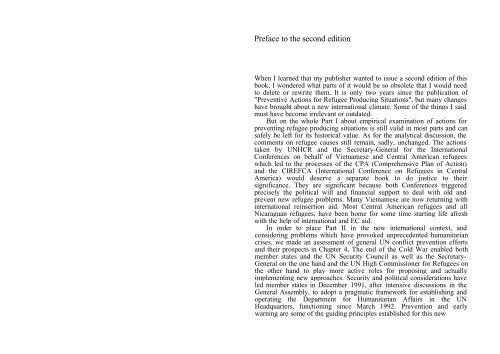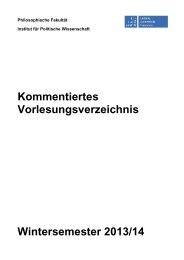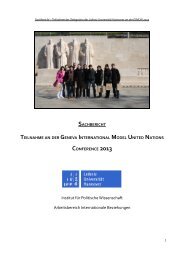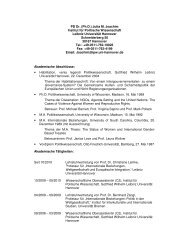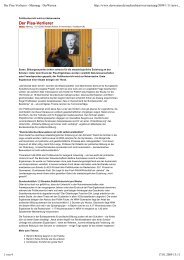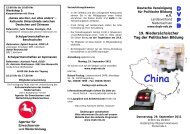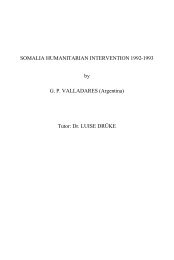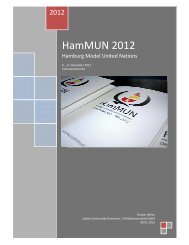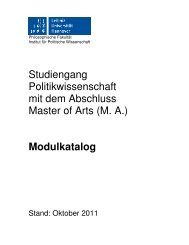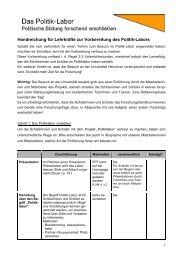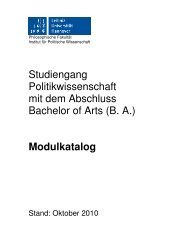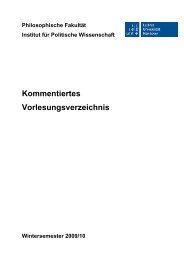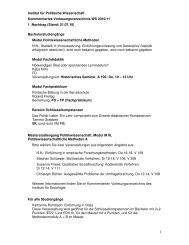Preventive Action for Refugee Producing Situations
Preventive Action for Refugee Producing Situations
Preventive Action for Refugee Producing Situations
You also want an ePaper? Increase the reach of your titles
YUMPU automatically turns print PDFs into web optimized ePapers that Google loves.
Preface to the second edition<br />
When I learned that my publisher wanted to issue a second edition of this<br />
book, I wondered what parts of it would be so obsolete that I would need<br />
to delete or rewrite them. It is only two years since the publication of<br />
"<strong>Preventive</strong> <strong>Action</strong>s <strong>for</strong> <strong>Refugee</strong> <strong>Producing</strong> <strong>Situations</strong>", but many changes<br />
have brought about a new international climate. Some of the things I said<br />
must have become irrelevant or outdated.<br />
But on the whole Part I about empirical examination of actions <strong>for</strong><br />
preventing refugee producing situations is still valid in most parts and can<br />
safely be left <strong>for</strong> its historical value. As <strong>for</strong> the analytical discussion, the<br />
comments on refugee causes still remain, sadly, unchanged. The actions<br />
taken by UNHCR and the Secretary-General <strong>for</strong> the International<br />
Conferences on behalf of Vietnamese and Central American refugees<br />
which led to the processes of the CPA (Comprehensive Plan of <strong>Action</strong>)<br />
and the CIREFCA (International Conference on <strong>Refugee</strong>s in Central<br />
America) would deserve a separate book to do justice to their<br />
significance. They are significant because both Conferences triggered<br />
precisely the political will and financial support to deal with old and<br />
prevent new refugee problems. Many Vietnamese are now returning with<br />
international reinsertion aid. Most Central American refugees and all<br />
Nicaraguan refugees, have been home <strong>for</strong> some time starting life afresh<br />
with the help of international and EC aid.<br />
In order to place Part II in the new international context, and<br />
considering problems which have provoked unprecedented humanitarian<br />
crises, we made an assessment of general UN conflict prevention ef<strong>for</strong>ts<br />
and their prospects in Chapter 4, The end of the Cold War enabled both<br />
member states and the UN Security Council as well as the Secretary-<br />
General on the one hand and the UN High Commissioner <strong>for</strong> <strong>Refugee</strong>s on<br />
the other hand to play more active roles <strong>for</strong> proposing and actually<br />
implementing new approaches. Security and political considerations have<br />
led member states in December 1991, after intensive discussions in the<br />
General Assembly, to adopt a pragmatic framework <strong>for</strong> establishing and<br />
operating the Department <strong>for</strong> Humanitarian Affairs in the UN<br />
Headquarters, functioning since March 1992. Prevention and early<br />
warning are some of the guiding principles established <strong>for</strong> this new


